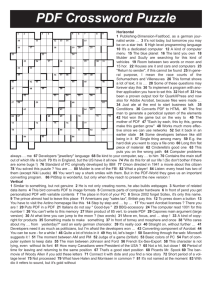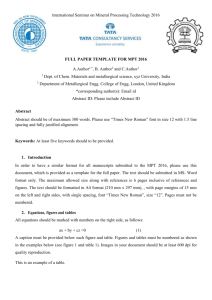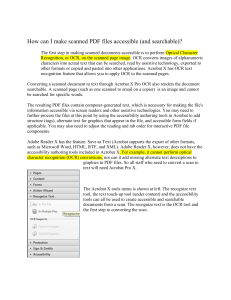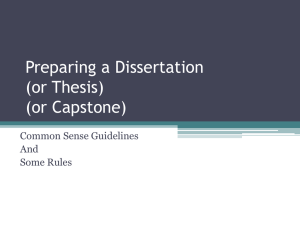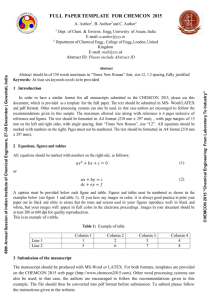MBARI | Staff
advertisement
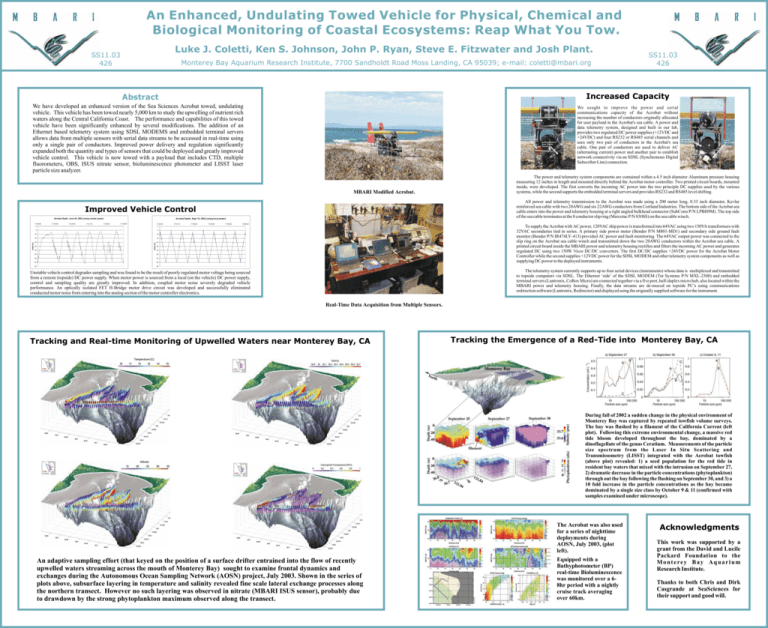
An Enhanced, Undulating Towed Vehicle for Physical, Chemical and Biological Monitoring of Coastal Ecosystems: Reap What You Tow. Luke J. Coletti, Ken S. Johnson, John P. Ryan, Steve E. Fitzwater and Josh Plant. SS11.03 426 Monterey Bay Aquarium Research Institute, 7700 Sandholdt Road Moss Landing, CA 95039; e-mail: coletti@mbari.org Increased Capacity Abstract We have developed an enhanced version of the Sea Sciences Acrobat towed, undulating vehicle. This vehicle has been towed nearly 5,000 km to study the upwelling of nutrient rich waters along the Central California Coast. The performance and capabilities of this towed vehicle have been significantly enhanced by several modifications. The addition of an Ethernet based telemetry system using SDSL MODEMS and embedded terminal servers allows data from multiple sensors with serial data streams to be accessed in real-time using only a single pair of conductors. Improved power delivery and regulation significantly expanded both the quantity and types of sensors that could be deployed and greatly improved vehicle control. This vehicle is now towed with a payload that includes CTD, multiple fluorometers, OBS, ISUS nitrate sensor, bioluminescence photometer and LISST laser particle size analyzer. We sought to improve the power and serial communications capacity of the Acrobat without increasing the number of conductors originally allocated for user payload in the Acrobat's sea cable. A power and data telemetry system, designed and built in our lab, provides two regulated DC power supplies (+12VDC and +24VDC) and four RS232 or RS485 serial channels and uses only two pair of conductors in the Acrobat's sea cable. One pair of conductors are used to deliver AC (alternating current) power and another pair to establish network connectivity via an SDSL (Synchronous Digital Subscriber Line) connection. MBARI Modified Acrobat. 11:16:48 11:24:00 11:31:12 11:38:24 Acrobat Depth, Sept 10, 2002 (using local power). 11:45:36 17:24:00 0 5 5 10 10 15 15 20 20 25 30 Depth (m). Depth (m). 11:09:36 0 17:31:12 17:38:24 17:45:36 17:52:48 18:00:00 To supply the Acrobat with AC power, 120VAC ship power is transformed into 64VAC using two 150VA transformers with 32VAC secondaries tied in series. A primary side power meter (Bender P/N M801-MD1) and secondary side ground fault monitor (Bender P/N IR474LY-413) provided AC power and fault monitoring. The 64VAC output power was connected to the slip ring on the Acrobat sea cable winch and transmitted down the two 20AWG conductors within the Acrobat sea cable. A printed circuit board inside the MBARI power and telemetry housing rectifies and filters the incoming AC power and generates regulated DC using two 150W Vicor DC/DC converters. The first DC/DC supplies +24VDC power for the Acrobat Motor Controller while the second supplies +12VDC power for the SDSL MODEM and other telemetry system components as well as supplying DC power to the deployed instruments. 25 30 35 35 40 40 45 45 50 50 The power and telemetry system components are contained within a 4.5 inch diameter Aluminum pressure housing measuring 12 inches in length and mounted directly behind the Acrobat motor controller. Two printed circuit boards, mounted inside, were developed. The first converts the incoming AC power into the two principle DC supplies used by the various systems, while the second supports the embedded terminal servers and provides RS232 and RS485 level shifting. All power and telemetry transmission to the Acrobat was made using a 200 meter long, 0.33 inch diameter, Kevlar reinforced sea cable with two 20AWG and six 22AWG conductors from Cortland Industries. The bottom side of the Acrobat sea cable enters into the power and telemetry housing at a right angled bulkhead connector (SubConn P/N LPBH9M). The top side of the sea cable terminates at the 8 conductor slip ring (Mercotac P/N 830SS) on the sea cable winch. Improved Vehicle Control Acrobat Depth, June 06, 2002 (using remote power). SS11.03 426 The telemetry system currently supports up to four serial devices (instruments) whose data is multiplexed and transmitted to topside computers via SDSL. The Ethernet ‘side’ of the SDSL MODEM (Tut Systems P/N MXL-2300) and embedded terminal servers (Lantronix, CoBox Micro) are connected together via a five port, half-duplex micro hub, also located within the MBARI power and telemetry housing. Finally, the data streams are de-muxed on topside PC’s using communications redirection software (Lantronix, Redirector) and displayed using the originally supplied software for the instrument. Unstable vehicle control degrades sampling and was found to be the result of poorly regulated motor voltage being sourced from a remote (topside) DC power supply. When motor power is sourced from a local (on the vehicle) DC power supply, control and sampling quality are greatly improved. In addition, coupled motor noise severely degraded vehicle performance. An optically isolated FET H-Bridge motor drive circuit was developed and successfully eliminated conducted motor noise from entering into the analog section of the motor controller electronics. Real-Time Data Acquisition from Multiple Sensors. Tracking and Real-time Monitoring of Upwelled Waters near Monterey Bay, CA Tracking the Emergence of a Red-Tide into Monterey Bay, CA During fall of 2002 a sudden change in the physical environment of Monterey Bay was captured by repeated towfish volume surveys. The bay was flushed by a filament of the California Current (left plot). Following this extreme environmental change, a massive red tide bloom developed throughout the bay, dominated by a dinoflagellate of the genus Ceratium. Measurements of the particle size spectrum from the Laser In Situ Scattering and Transmissometry (LISST) integrated with the Acrobat towfish (above plot) revealed: 1) a seed population for the red tide in resident bay waters that mixed with the intrusion on September 27, 2) dramatic decrease in the particle concentrations (phytoplankton) through out the bay following the flushing on September 30, and 3) a 10 fold increase in the particle concentrations as the bay became dominated by a single size class by October 9 & 11 (confirmed with samples examined under microscope). The Acrobat was also used for a series of nighttime deployments during AOSN, July 2003, (plot left). An adaptive sampling effort (that keyed on the position of a surface drifter entrained into the flow of recently upwelled waters streaming across the mouth of Monterey Bay) sought to examine frontal dynamics and exchanges during the Autonomous Ocean Sampling Network (AOSN) project, July 2003. Shown in the series of plots above, subsurface layering in temperature and salinity revealed fine scale lateral exchange processes along the northern transect. However no such layering was observed in nitrate (MBARI ISUS sensor), probably due to drawdown by the strong phytoplankton maximum observed along the transect. Equipped with a Bathyphotometer (BP) real-time Bioluminescence was monitored over a 68hr period with a nightly cruise track averaging over 60km. Acknowledgments This work was supported by a grant from the David and Lucile Packard Foundation to the M o n t e re y B a y A q u a r i u m Research Institute. Thanks to both Chris and Dirk Casgrande at SeaSciences for their support and good will.
